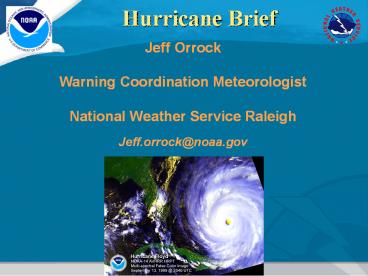Hurricane Brief - PowerPoint PPT Presentation
Title:
Hurricane Brief
Description:
Just one of these hurricanes hitting NC will make it a bad season. for someone ... County # of Bldgs Damaged. County. Numbers represent all wind damage ... – PowerPoint PPT presentation
Number of Views:78
Avg rating:3.0/5.0
Title: Hurricane Brief
1
Hurricane Brief
Jeff Orrock Warning Coordination
Meteorologist National Weather Service
Raleigh Jeff.orrock_at_noaa.gov
2
(No Transcript)
3
The FutureLook to the Past
4
1930 - 2005
5
Costliest Storms in US History
6
NOAA Hurricane Outlook9 of the last 11
Hurricane Seasons have been have been above normal
7
2006 NOAA Hurricane Outlook
13 - 16 Named Storms ( 11 is the normal average
28 in 2005) 8 - 10 Hurricanes ( 6 is the normal
average 15 hurricanes in 2005) 4 - 6 Major
Hurricanes (Cat 3 or greater with winds 111 mph
or greater) ( 2 is the normal average
7 major in 2005)
Just one of these hurricanes hitting NC will make
it a bad season for someone
8
80 chance above normal, 15 chance near normal,
5 chance below normal
9
(No Transcript)
10
NOAAs 2006 Seasonal Hurricane Outlooks
Atlantic East Pacific Central
Pacific
Outlook Outlook
Outlook
Chance Above Normal 80
5 Chance Near Normal 15
15 NA Chance Below Normal
5 80
Tropical Storms
13-16 12-16
2-3 tropical systems Hurricanes
8-10 6-8
(includes tropical Major Hurricanes
4-6 1-3
depressions) ACE of Median 135-205
45-85 Categorical
Above Below
Below Outlook
Normal Normal Normal
80 is highest probability ever issued in a
May Outlook
14
11
(No Transcript)
12
Chris Landsea NOAA Hurricane Research Division
1995 Normalized data clearly indicates the US
has been fortunate in recent decades with respect
to storm losses. This would lead to the
conclusion that it is only a matter of time
before the nation experiences a 50 billion or
greater storm, with multi billion dollar losses
becoming increasingly frequent. Climate
fluctuations in the Atlantic basin will enhance
the chances that this will occur sooner rather
than later.
Law of Averages One land falling hurricane every
3-4 years One or more hurricanes will impact the
NC every one and a half years.
13
NC Population Vulnerability
NC population has increased from 4 million to
over 8.4 million since 1954 Coastal populations
have more than quadrupled
Top 5 most populated counties
Top 5 most densely populated counties
14
The Threat
Top 5 fastest growing counties and Largest
municipalities
Hazel or Hugo size storm moving from SE coast
into central NC impacting some of the most
densely populated areas in the state. Winds in
excess of 90 Mph along with 8-10 inches of rain.
Cut all major east-west and north-south roads in
the state.
15
Our test to come
- _at_ 4 million people impacted from ILM to RDU
- 391,081 buildings will be at least moderately
damaged (of this 386,000 are residential) - Estimated 90,342 buildings that will be
completely destroyed (mostly residential) - Nearly 8 times that of Hurricane Floyd
- All major N-S and E-W highways compromised
16
Wind damage alone is 8 times the total damage
from Hurricane Floyd
County of Bldgs Damaged County of Bldgs Damaged
Alamance 11,000 Lee 12,000 (6,000)
Bladen 12,000 (10,000) Moore 24,000 (12,000)
Brunswick 47,000 (42,000) New Hanover 64,000 (56,000)
Caswell 700 Onslow 20,000
Chatham 10,300 Orange 12,000
Columbus 16,000 (10,000) Pender 17,000 (13,000)
Cumberland 94,000 (68,000) Person 1,700
Duplin 12,000 (6,000) Randolph 12,000
Durham 26,000 Robeson 38,000 (29,000)
Forsyth 20,000 Rockingham 1,300
Guilford 18,000 Sampson 19,000 (14,000)
Harnett 27,000 Scotland 11,000
Hoke 9,000 (7,000) Wake 114,000 (34,000)
Johnston 27,000 (10,000) Wayne 22,000
Numbers represent all wind damage
( ) Moderate damage and worse
17
Shelters and Evacuations
- 181,880 households displaced due to the
hurricane.
18
The Trees and Debris
200-300 trees down for every mile of highway In
Fayetteville, Triangle and Triad 6-12 trees down
per city block
19
The Rain8 12 inches
Major to record flooding along Cape Fear, Neuse,
and Haw Rivers including countless creeks. Haw
River would rise within 12 hours cresting near 35
feet flooding Interstate 40 west of Raleigh Kerr
Lake, Falls Lake and Lake Jordan could overtop
flood controls. Numerous small dam failures.
20
Jeff Orrockjeff.orrock_at_noaa.govhttp//weather.
gov/raleigh(919) 515-8209































